
Being the owner of a small caravan site, I often get to chat with my guests about their latest purchases for their caravan or motorhome. With this post, I thought I would discuss caravan and motorhome leisure batteries. Today, we use more electrical devices in our caravans and motorhomes than ever before. We also have more electrical devices fitted on the outside, motor movers being a typical example. Therefore the type, size and quality of the leisure batteries we choose can make a big difference in how we can use our caravans and motorhomes. As a starting point, check out the video below.
This is a pretty long post, so to make it easy to navigate, I’ve provided a Table of Contents for the different parts of the page:
Disclaimer: Hey! By the way… any links on this page that lead to products on Amazon or Caravan Guard are affiliate links, and I earn a commission if you make a purchase, with no additional cost to you 🙂
- Dissolves waste and removes odours naturally and has delightful mild fragrance
Want To Visit Horton Common? – Book Here
Table of Contents
How To Choose A Leisure Battery?
So there are two possible reasons you may need to purchase a new leisure battery.
Either your old battery has lost capacity and died, or the type and size of your battery are no longer suitable for how you use your caravan or motorhome.
Before you start to do your shopping list for a new leisure battery, you need to ask yourself some questions:
- How often do you go ‘off grid’?
- Do you have a motormover fitted to your caravan?
- What is the power rating of the motor mover?
- Do you have an alarm tracker system fitted?
- Is your tow car fitted with a Euro 6 Engine?
- Do you want a dual leisure battery setup?
The meaning and relevance of all these questions may not at first be apparent. However, after reading the rest of the post below hopefully, it should become clear.
What Are The Main Types Of Leisure Battery?
In terms of the leisure batteries on offer today for your caravan or motorhome, they use a range of technologies which include:
- Open Lead Acid Leisure Batteries
- Sealed Lead Acid Leisure Batteries
- AGM (Absorbed Glass Mat) Leisure Batteries
- Gel Leisure Batteries
- Lead Crystal Leisure Batteries
- Lithium LiFePO4 leisure batteries
You may have noticed that I’ve added two additional categories of leisure battery (Lead Crystal and Lithium) where the video only references four categories.
Both of these categories are recent introductions to the market, and the video was produced in 2016.
However, it’s still the best and most concise video introduction on the net for leisure batteries. I’m sure they will update it at some point.
Open Lead Acid Leisure Batteries
Essentially, open lead acid is where all batteries started, and it’s still going strong. Another term used to describe them is ‘flooded batteries’.
In the simplest terms, lead plates sit in a liquid solution of sulphuric acid. Open lead-acid batteries have removable caps where the electrolyte can be topped up to maintain battery performance.
How often an open lead-acid battery needs topping up with electrolyte (typically distilled water) depends on usage. At or near full charge, the battery is ‘off-gassing’.
It’s important to check that the top of the lead plates is covered by the electrolyte. If the lead plates are left exposed, they will ‘sulphate’ and become damaged.
So open lead-acid battery maintenance is important.
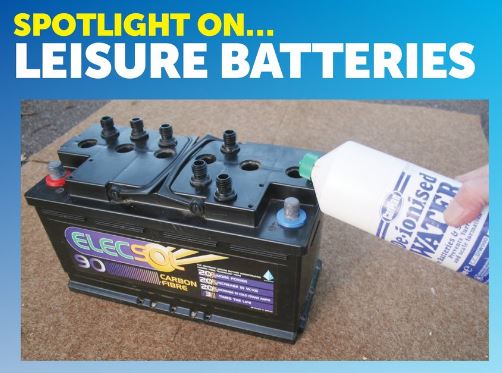
It’s also important to note that discharging a lead-acid battery below 50% of its capacity can cause irreparable damage.
However, if you only ever visit sites with electrical hookups and you don’t have a motor mover, open lead-acid batteries are a cheap option to consider.
- + Cheapest option for a Leisure Battery
- – Does require attention and maintenance.
- – Permanent damage below a 50% discharge
- – Quite Heavy
Sealed Lead Acid Leisure Batteries
If the idea of maintaining an open lead-acid leisure battery doesn’t appeal to you, the next option is a sealed lead-acid battery. Let’s be honest, sulphuric acid is nasty stuff.
So with a sealed lead acid battery, you don’t have to worry about it. Therefore sealed lead acid batteries are often referred to as ‘maintenance free’.
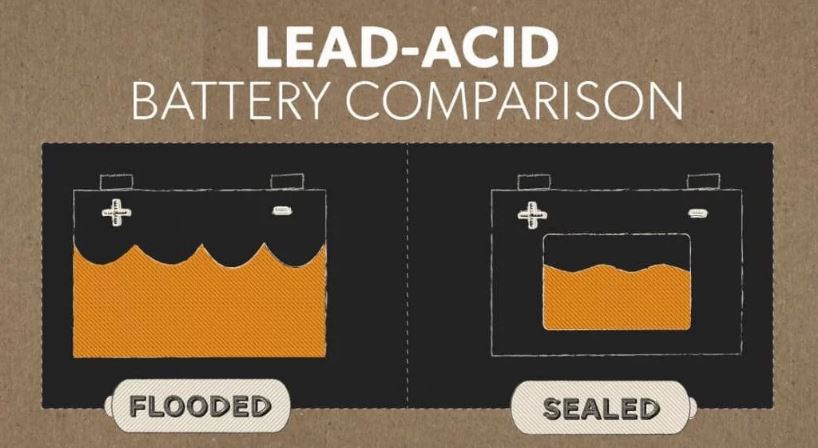
Sealed lead acid still has the issue of permanent damage below a 50% discharge. You will also pay a bit more for a sealed compared to a flooded lead-acid battery.
Sealed batteries are designed to operate for a certain number of cycles. They are also referred to as VRLA (valve regulated lead-acid) batteries.
This lets gasses escape during the charging cycle. Therefore its potentially possible (with proper maintenance) for an open lead-acid battery to have a longer service life.
- + Maintenance free compared to open lead-acid
- + Safer than open lead-acid
- – Permanent damage below a 50% discharge
- – More expensive than open lead-acid
- – Quite Heavy
AGM (Absorbed Glass Mat) Leisure Batteries
So AGM batteries still contain lead and an electrolyte, but with a different construction. The electrolyte is trapped within a fibreglass mat.
AGM batteries are also a form of VRLA (valve regulated lead-acid) batteries to stop a build-up of pressure within the battery.
A specific benefit of AGM batteries is their ability to cope well with vibration.
Therefore as you will appreciate, with the significant number of potholes on UK roads, their ability to cope well with vibration makes them a great choice for caravans and motorhomes.
Also, as they can’t leak, they can even be mounted on their side, giving you more options on potentially fitting two batteries.

Banner is a popular brand of AGM leisure batteries: Image – Amazon.co.uk
You can also discharge an AGM battery a bit further below 50% without causing damage. The downsides are you will have to spend more on an AGM than either a flooded or sealed battery.
Also, they will have a shorter operating life. However, if you only do some infrequent off-grid camping or you have a motormover, an AGM should be a serious consideration.
- + Discharge below 50% without damage (around 60%)
- + Copes better with vibration (potholes)
- + Better suited for motor movers
- – Reduced service life to open/sealed batteries.
- – More expensive than open/sealed batteries.
Gel Leisure Batteries
Gel Leisure batteries are very similar to AGM technology in that they are leak and maintenance-free with VRLA to control pressure.
However, instead of using a fibreglass mat to suspend the electrolyte, it has been made into a thick pasty gel.
The main advantage of Gel batteries is their discharge rate. A Gel battery can be discharged as low as 80% without permanent damage.
Therefore, if you are a frequent off-grid camper, a Gel battery may be for you.
Another advantage of gel batteries is they can have a longer service life over 25 degrees Celcius.
However, if you only use your motorhome or caravan in the UK, the number of days above this temperature is pretty rare.

Gel leisure batteries are suitable for low discharges down to 80% without damage: Image – Amazon.co.uk
Now, there are two main downsides to Gel batteries over AGM. Not only are they more expensive, but they also do not handle high discharge and recharge rates as well.
- + Can discharge down to 80% without damage
- + Suitable for frequent off-grid camping
- + Longer service life at higher temperatures
- – Poorer performance on high charge/discharge rates
- – Not ideal for high load motor movers
- – More expensive than AGM leisure batteries
Lead Crystal Leisure Batteries
Now, Lead Crystal leisure batteries are very similar to AGM batteries, with a few differences. The construction of the mat and electrolyte is different.
The video below serves as a good introduction to what a lead crystal battery is and how it works.
I’ll briefly summarise the benefits of a lead crystal battery. This technology does not suffer from sulfation, so what that means is you can deplete the battery without permanent damage.
You can discharge down to 0V and fully charge back up from 0V.
Now, as you can appreciate from the features of the other lead battery technologies above, that’s pretty amazing! You can even leave a lead crystal battery at a partial rate of change without damaging it.
A lead crystal battery will also provide a significant advantage in the number of charge cycles. Typically it will have a lifespan triple that of a standard sealed lead battery. It also still performs well in cold and hot temperatures.
The only real downside, you guessed it, is price. You’ll typically have to spend around double that of an open/flooded battery. Finding lead crystal batteries available for sale is also currently quite difficult.
- + No issues with sulphation damage
- + Full discharge and full recharge is possible
- + Triple the lifespan of an AGM battery
- – Typically, double the price of an AGM battery
Lithium (LiFePO4) Leisure Batteries
You’ll typically find lithium batteries in your phone and laptop. They are also predominantly used in hybrid and electric cars.
In terms of leisure batteries for caravans and motorhomes, Lithium batteries, also known as LiFePO4 and have some significant benefits.
Compared to lead-acid technology, Lithium can provide roughly double the energy density for half the weight!
Lithium batteries will also last much longer than lead-acid, up to potentially ten times longer. They also cope much better with frequent discharges to around 80% of their capacity.
As you will have noted above, lead-acid batteries can be permanently damaged by going below 50% of their capacity.
However, if a Lithium battery is fully discharged, it can cause damage. That’s why Lithium batteries have electronic controllers to stop full discharges.

Lithium leisure batteries have a much higher energy density and lower weight, however currently they are significantly more expensive: Image – Amazon.co.uk
The only real downside to Lithium leisure batteries is their current cost. You will have to spend significantly more than you would for even the best lead-acid batteries.
However, as electric cars start to become more common expect that price to drop significantly and for Lithium leisure batteries to become the default for caravans and motorhomes.
- + High energy density with low weight
- + Copes well with frequent and deep discharges
- – Currently significantly more expensive
Used 12V Lithium Batteries
So as you can see from the information above, 12V lithium batteries have some significant benefits when it comes to their use as a leisure battery.
The biggest downside is their cost. However, I recently became aware of Valance 12V lithium batteries.
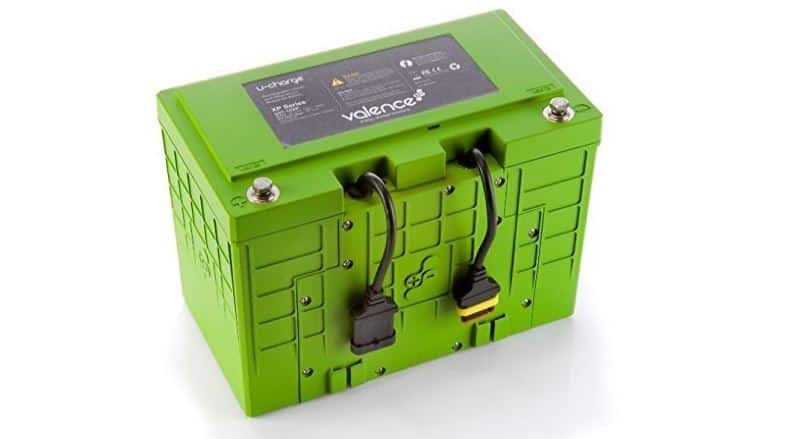
You will find Valance lithium batteries used in commercial EV vehicles and various other commercial applications.
In the commercial sector, they typically replace these batteries every couple of years. However, these batteries are reported by some people to still have 90%+ of their capacity remaining!
Now, the ‘secret’ appears to be out about these used 12V leisure batteries, and demand is currently outstripping supply.
However, it’s expected many more of these used 12V lithium batteries are going to be available in the coming years.
What Sizes of Leisure Battery Are Available?
With leisure batteries, you need to consider their physical size and their amp hour (AH) rating. So first, let’s deal with the physical size.
You need to go out and measure the battery tray in your caravan or motorhome.
Depending on the size of the battery currently fitted, there may be some spare space to fit a larger battery. As you would expect, a battery with a higher AH rating will generally also be physically larger.
The lowest AH rating you find fitted to most caravans today is 70AH. With a motor mover, a minimum of 70AH is required, though closer to 100AH is recommended.
However, if you have space and are looking for the extra capacity, you can go much higher than 100AH.
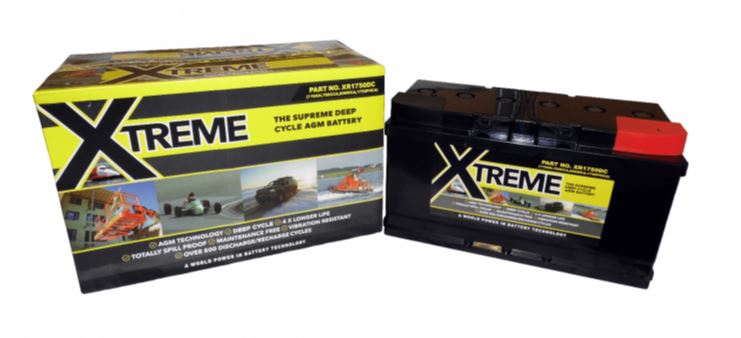
How Do You Choose the Size of Leisure Battery You Need?
If you own a motorhome and you pretty much only ever use mains serviced pitches, a 70AH battery will probably do you fine.
However, if you will be doing a bit of light off-grid camping with your motorhome, going up to 100AH is advisable.
If you are a full-time off-grid camper, then depending on the space available, you could consider going for a larger leisure battery.
If you own a caravan, don’t own a motor mover and only use mains hookup sites, then 70AH may be sufficient.
However, if you want to upgrade to a motor mover in the future, that battery is probably going to need upgrading, 100-150 AH will provide you with lots of power.
As shown above, there are monster batteries available going up to 330AH. However, you’ll be looking at £500 for a 330AH battery, and they weigh nearly enough 90kg!
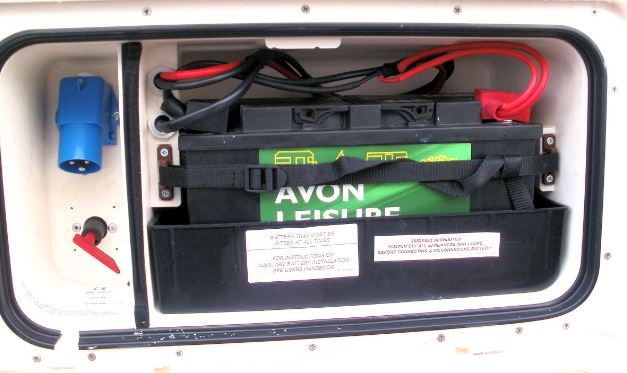
How The Leisure Battery Gets Charged
You may get some charge into your leisure battery while you’re towing your caravan or driving your motorhome.
You will also be putting charge into the battery when you’re plugged into the mains at home or at your pitch.
Charging While Driving and Towing
In most cases, your car will either maintain the charge of your leisure battery while towing or may even charge it. However, the charge rate while towing is generally pretty slow.
Something to be aware of though, is if you have a Euro 6 engine, your car may not maintain the charge in your leisure battery!
The problem is to do with Euro 6 cars using regenerative braking to charge the leisure battery instead of the alternator.
The issue became apparent when some caravanners noticed their fridges were not working while towing. This doesn’t appear to be an issue in all cases. However, this post I’ve written on it is worth a read.
Charging via the Mains Hookup Connection
The rate of charge will depend on how sophisticated your onboard charger is and the rated supply from the mains. For instance, at Horton Common, we provide a full 16A on our fully serviced pitches.
However, as you may know, other sites may only provide 10A, or in continental Europe, it’s quite common for sites to only offer 6A.
Therefore the rate of charge to your leisure battery will depend on the rating of the mains hookup supply.
Portable Leisure Battery Chargers
Really, every caravan or motor owner should have a good quality portable leisure battery charger.
I’ve also written a post on the best leisure battery chargers you can currently buy and the differences between onboard and portable chargers.
Caravan and Motorhome Solar Panels
It’s getting more and more popular to fit solar panels onto caravans and motorhomes to top up leisure batteries.
Obviously, the more solar cells, the faster the recharge rate. I’ve also written a post on caravan solar panels, which you may want to read.
What are the Best Leisure Battery Brands?
I thought I would separate the different brands under different leisure battery technologies they offer:
Open and Sealed Lead Acid: Banner, Bosch, Exide, Leoch, Varta and Xplorer.
AGM: Banner, Exide, Varta and Xplorer.
Gel: Exide and Leoch
Lead Crystal: Betta Batteries
Lithium: Leoch, Relion and Valence
Leisure Battery FAQ
Below I’ve done a brief FAQ section on caravan and motorhome leisure batteries. I hope you find it useful.
What Leisure Batteries do Caravan and Motorhome manufacturers typically fit?
In the UK, as standard most caravan and motorhome manufacturers will send the units out of the factory with a sealed lead-acid battery.
Some of the top-end models that come fitted with a motormover have an AGM battery fitted. Apparently, some European manufacturers prefer to fit Gel batteries.
As discussed previously, Gel batteries do cope well with low discharges down to 80%. Therefore European customers may spend more time off-grid and require a battery to suit.
How much do Leisure Batteries Weigh?
The weight will depend on the physical size of the battery and the technology it’s based on. The important thing to remember is leisure batteries are generally pretty heavy.
If when you load up your caravan, you get close to the caravans MTPLM weight, additional Kilos could cause problems.
A typical 100AH lead acid leisure battery will weigh around 25kg. The largest (and heaviest) leisure batteries up to 330AH weigh around 90kg.
Notably, Lithium batteries weigh considerably less, for a 100AH battery, the weight will only be around 13kg.
Where on your caravan the leisure battery is stored is worth thinking about.
The closer the leisure battery is to the nose of the caravan, the more of an impact it will have on the caravan’s nose weight. Caravan manufacturers obviously know this and generally mount the leisure battery over the axle.
However, this is not always the case, so something to consider when choosing the size and weight and your next leisure battery. Motorhome leisure battery placement is also important to consider for similar reasons.
What is the difference between a Leisure Battery and a Normal Car Battery?
A car battery has one main job, to start an engine. Therefore it has to provide a lot of power, very quickly and over a short period of time.
As soon as the engine is running, the alternator quickly puts the lost power back into the battery. This process is referred to as micro-cycling.
A leisure battery, on the other hand, needs to provide less power over a longer period of time. It can provide surges of power (to run motor movers), but that’s not its primary purpose.
A leisure battery, instead of being designed for micro-cycling, is designed for deep-cycling.
In other words, even a basic leisure battery is designed to cope with being discharged down to around 50%. If you discharged a car battery frequently to 50%, it would have a very short operating life.

What is a Deep Cycle Battery?
A deep-cycle battery is designed to be frequently discharged and recharged to a significant proportion of its capacity.
Standard lead-acid batteries can typically be discharged to 50% without damage, provided they are not held at a depleted state of charge.
AGM leisure batteries can be discharged to around 60%, where Gel batteries can be discharged down to 80% without damage.
The most advanced deep cycle leisure batteries are Lead Crystal and Lithium technologies. Both can be frequently discharged to near zero capacity without causing permanent damage.
Do you have to use a Leisure Battery in a Caravan or Motorhome?
Technically no, you could fit a standard car battery in a caravan or motorhome. However, the service life of the battery would be very short before significant sulphation took place and permanently damaged the battery.
Can you Overcharge a Leisure Battery?
Overcharging of leisure batteries is an issue if the battery is not compatible with the onboard charger of your caravan or motorhome.
Therefore, before you choose your next leisure battery, especially if you’re changing from one battery technology to another, you need to check your manual.
If your manual doesn’t make it clear what type of battery technology your battery charger is compatible with, give them a ring or send them an email.
For instance, a Lithium based leisure battery may work fine, but the manual was printed before they became commonly available on the market.
Does Temperature affect the Performance of a Leisure Battery?
Yes, the temperature outside does affect the performance of a leisure battery. For instance, the amp hour ratings that manufacturers state is tested at 25 degrees Celsius.
Hence, the equivalent of a warm summer’s day in the UK.
Below this temperature, the performance of the battery is reduced. If you are using your caravan or motorhome in the winter and its freezing outside, the battery will have lost about 20% of its rating performance.
So if you are a winter camper and you have a motor mover fitted, for instance, you need a high amp hour-rated battery.
As noted earlier in the post, you should not use a standard open or sealed lead acid battery below 50% of its rated capacity.
If you do, you can cause permanent damage to its performance. Therefore using lead-acid batteries in cold temperatures with high-load devices (motor movers) is not ideal.
Can you fit more than one Leisure Battery?
Sure, if you have space (and weight allowance) in your caravan or motorhome. You’ll also need to fit a suitable battery charger to evenly discharge and charge both batteries.
Leisure Batteries and Security Trackers
Most securing trackers are fitted with their own small rechargeable battery. However, when that battery runs out of charge, it will pull power from the leisure battery.
During the colder months of the year, when your caravan or motorhome is in storage, the tracker will be using power.
Therefore it’s important to make sure you have a quality battery of a sufficient size that can give the tracker the power it needs.
What are the Best Leisure Batteries for Solar Panels on your Caravan or Motorhome?
Really, you can use any leisure battery technology with a solar panel on your caravan or motorhome.
There are some discussions that Gel and Lithium as best suited to the irregular charge provided from solar panels.
However, even basic lead-acid batteries have been used in off-grid applications successfully for decades.
Can you run an electric kettle in your caravan or motorhome from a leisure battery?
I’ve done a post on caravan kettles where I discuss this more, but yes, you can get a 12V kettle to run from a leisure battery. However, a 12V kettle is not very practical as it takes 42 minutes to boil 1L of water!
Really, when it comes to kettles, the most practical option is to use your gas stove instead of pulling power from your leisure battery. You can also consider a refillable gas cylinder to keep running costs down.
You could also potentially power a caravan microwave from a leisure battery with a 12V to 230V inverter. However, you’re going to need a pretty high-capacity leisure battery for that to be feasible or practical.
Want To Visit Horton Common? – Book Here


